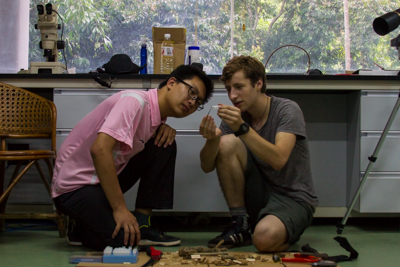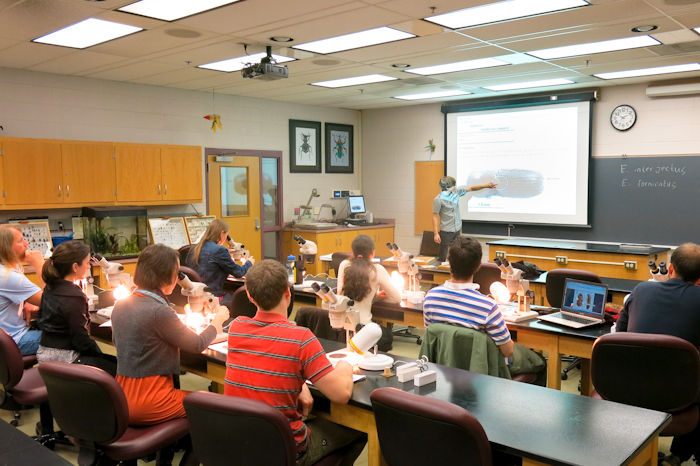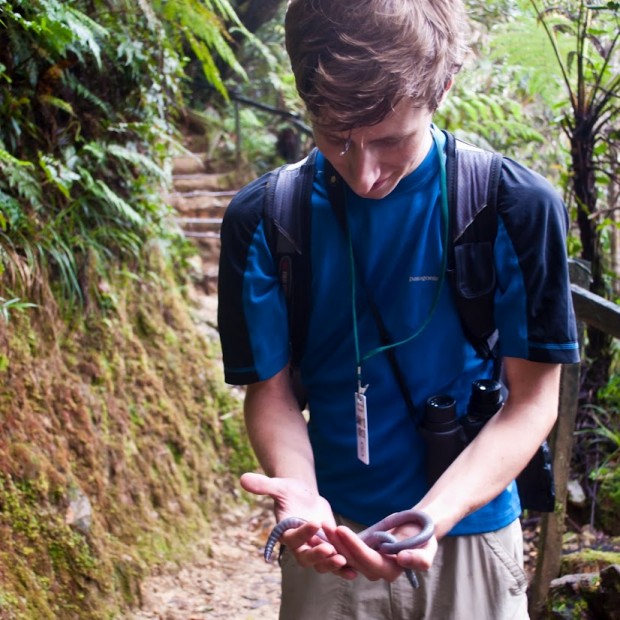Contact
batemanc@gmail.comShort Bio & Research Summary
I am an insect symbiologist with research interests ranging from forest pathology to population genetics and community ecology. Please email me if you have any questions or are interested in collaborating!Current projects
- Evaluating pathogen potential in exotic ambrosia fungi
- Biogeography of globally distributed ambrosia fungi
- Uncovering coevolutionary relationships in the ambrosia symbiosis
- Detection of coffee berry borer in Papua New Guinea. See here for more info
Education
- 2014-2018: PhD. in Entomology, University of Florida
- 2012-2014: M.S. in Forestry, University of Florida
- 2008-2012: B.S. in Entomology, Michigan State University
Skelton, J., Jusino, M.A., Li, Y., Bateman, C., Thai, P.H., Wu, C., Lindner, D.L. and Hulcr, J., 2018. Detecting Symbioses in Complex Communities: the Fungal Symbionts of Bark and Ambrosia Beetles Within Asian Pines. Microbial ecology, pp.1-12.
Mayers, C.G., Bateman, C. and Harrington, T.C., 2018. New Meredithiella species from mycangia of Corthylus ambrosia beetles suggest genus-level coadaptation but not species-level coevolution. Mycologia, 110(1), pp.63-78.
Li, Y., Bateman, C., Skelton, J., Jusino, M.A., Nolen, Z.J., Simmons, D.R., Hulcr, J. 2017, in press. Wood decay fungus Flavodon ambrosius (Basidiomycota: Polyporales) is widely farmed by two genera of ambrosia beetles. Fungal Biology, 121(11), pp.984-989.
Bateman, C., Huang, Y., Simmons, D.R., Kasson, M.T., Hulcr, J. 2017. Ambrosia beetle Premnobius cavipennis (Scolytinae: Ipini) carries highly divergent ascomycotan ambrosia fungus, Afroraffaelea ambrosiae gen. nov. sp. nov. (Ophiostomatales). Fungal Ecology, 25, pp.41-49.
O’Donnell K., Libeskind-Hadas R., Hulcr J., Bateman C., Kasson M.T., Ploetz R.C., Konkol J.L., Carrillo D., Campbell A., Duncan R.E., Liyanage P.N.H., Eskalen A., Lynch S.C., Freeman S., Mendel Z., Sharon M., Geiser D.M., Aoki T., Cosse A.C., Rooney A.P. 2016 Invasive Asian Fusarium – Euwallacea ambrosia beetle mutualists pose a serious threat to forests, urban landscapes and the avocado industry. Phytoparasitica, 44(4), pp.435-442.
Short, D.P.G., O’Donnell, K., Stajich, J.E., Hulcr, J., Kijimoto, T., Berger, M.C., Macias, A.M., Spahr, E.J., Bateman, C., Eskalen, A., Lynch, S.C., Cognato, A.I., Cooperband, M.F. 2016. PCR multiplexes discriminate Fusarium symbionts of invasive Euwallacea ambrosia beetles that inflict damage on numerous tree species throughout the United States. Plant Disease.
Simmons D.R., De Beer Z.W., Huang Y-T., Bateman C., Campbell A.S., Dreaden T.J., Li Y., Ploetz R.C., Li H-F., Chen C-Y., Wingfield M.J., Hulcr J. 2016. New Raffaelea species (Ophiostomatales) from the United States and Taiwan associated with ambrosia beetles and plant hosts. IMA Fungus.
Li, Y., Gu, X., Kasson, M.T., Bateman, C., Guo, J., Huang, YT., Li, Q., Rabaglia, R.J., J. 2016. Distribution, host records and symbiotic fungi of Euwallacea fornicatus (Eichhoff) (Coleoptera: Curculionidae: Scolytinae) in China. Florida Entomologist.
Bateman, C., Sigut, M., Skelton, J., Smith, K.E., Hulcr, J. 2016. Fungal associates of the black twig borer, Xylosandrus compactus (Coleoptera: Curculionidae, Scolytinae), are spatially segregated on the insect body. Environmental Ecology.
Simmons D.R., Li Y., Bateman C., Hulcr J. 2016. Flavodon ambrosius sp. nov., a basidiomycetous mycosymbiont of Ambrosiodmus ambrosia beetles. Mycotaxon.
Bateman, C. and Hulcr, J. 2016. Predaceous Diving Beetles as Pets and the Self-Cleaning Aquarium. Electronic Data Information Source of UF/IFAS Extension.
Lynch, S.C., Twizeyimana, M., Mayorquin, J.S., Wang, D.H., Na, F., Kayim, M., Kasson, M.T., Thu, P.Q., Bateman, C., Rugman-Jones, P. and Hucr, J., 2016. Identification, pathogenicity and abundance of Paracremonium pembeum sp. nov. and Graphium euwallaceae sp. nov.-two newly discovered mycangial associates of the polyphagous shot hole borer (Euwallacea sp.) in California. Mycologia, pp.15-063.
Bateman, C., Kendra, P.E., Rabaglia, R., Hulcr, J. 2015. Fungal symbionts in three exotic ambrosia beetles, Xylosandrus amputatus, Xyleborinus andrewesi, and Dryoxylon onoharaense (Coleoptera: Curculionidae: Scolytinae: Xyleborini) in Florida. Symbiosis.
Li, Y., Simmons, D. R., Bateman, C. C. Short, D. P. G., Kasson, M. T., Rabaglia, R., Hulcr, J. 2015. New fungus-insect symbiosis: molecular, culturing, and histological methods determine saprophytic Polyporales mutualist of Ambrosiodmus ambrosia beetles. PLoS ONE.
Bateman, C., Hulcr J. 2014. A guide to Florida’s common bark and ambrosia beetles. Electronic Data Information Source of UF/IFAS Extension.
O’Donnell, K., Sink, S., Libeskind-Hadas, R., Hulcr, J., Kasson, M. T., Ploetz, R. C., Konkol, J. L., Ploetz, J. N., Carrillo, D., Campbell, A., Duncan, R. E., Liyanage, N. H. P., Eskalen, A., Na, F., Geiser, D. M., Bateman, C., Freeman, S., Mendel, Z., Sharon, M., Aokij, T., Cossé, A. A., & Rooney, A. P. (2014). Discordant phylogenies suggest repeated host shifts in the Fusarium Euwallaceaambrosia beetle mutualism. Fungal Genetics and Biology.
Kostovcik, M., Bateman, C. C., Kolarik, M., Stelinski, L. L., Jordal, B. H., & Hulcr, J. (2014). The ambrosia symbiosis is specific in some species and promiscuous in others: evidence from community pyrosequencing. The ISME journal.
Kasson, M. T., K. O’Donnell, A. Rooney, S. Sink, R. Ploetz, J. N. Ploetz, J. L. Konkol, D. Carrillo, S. Freeman, Z. Mendel, J. A. Smith, A. W. Black, J. Hulcr, C. Bateman, K. Stefkova, P. R. Campbell, A. D. Geering, E. K. Dann, A. Eskalen, K. Mohotti, D. P. Short, T. Aoki, K. A. Fenstermacher, D. D. Davis, and D. M. Geiser. 2013. An inordinate fondness for Fusarium: phylogenetic diversity of fusaria cultivated by ambrosia beetles in the genus Euwallacea on avocado and other plant hosts. Fungal Genetics and Biology 56:147-157.
Bateman, C. Prevention and rapid response of the Coffee Berry Borer in Papua New Guinea. American Society for Horticultural science. Waikoloa, HI. Invited Talk.
Bateman, C. Symbiotic and pathogenic fungi associated with wood-boring ambrosia beetles. 2017 International Congress on Forest Protection. Quevedo, Ecuador. Invited Talk.
Bateman, C., Smith, S., Martinez, M., Skelton, J., Hulcr, J. 2017. Patterns in coevolution revealed from a global analysis of ambrosia beetles and fungi. Southern Forest Insect Working Conference. Melbourne, FL.
Bateman, C., Smith, S., Skelton, J., Hulcr, J. 2017. Coevolutionary patterns in ambrosia fungi and beetles revealed from a global survey. Mycology Society of America annual meeting. Athens, GA.
Bateman, C. and Hulcr, J. 2016. Assessing coevolution between the hyper-diverse ambrosia beetles and their microbiomes. International Congress of Entomology. Orlando, FL. Invited talk.
Bateman, C. and Hulcr, J. 2016. Protecting Papua New Guinea coffee from the coffee berry borer. Conservation and Development in SE Asia Research Symposium. Gainesville, FL.
Bateman, C. and Hulcr, J. 2015. Mycobiont maintenance: Establishing the basis for symbiont identity, specificity, and diversity in the ambrosia symbiosis. Entomology Society of America Annual meeting. Minneapolis, MN. Invited talk.
Bateman, C.. 2015. Ambrosia beetle microbiomes: invasion, symbiosis, and sex. Population Biology seminar, University of Florida Biology Department.
Bateman, C., Hulcr, J., Smith, J., Li, Y., Black, A., Wang, B., Sittichaya, W. 2015. Protecting American pine forests: Are unknown pathogens hiding in Asia? Graduate Student Symposium, University of Florida School of Forest Resources and Conservation
Bateman, C., Wang, B., Sittichaya, W., Hulcr, J. 2014. Protecting American pine forests: Are unknown pathogens hiding in Asia? Entomology Society of America Annual meeting. Portland, OR. Invited Talk.
Hulcr, J, Bateman, C.* 2014. Battling the emerging ambrosia beetle pests: what works and what does not. Invited Talk. *=presenting author
Bateman, C., J. Hulcr, Y. Li, B. Wang, W. Sittichaya, A. Black 2014. Predicting future exotic pathogens: A decision support tool for protecting American forests. Continental Dialogue on Non-Native Forest Insects and Diseases. Ten-minute talk.
Hulcr, J.*, Bateman, C., Smith, J., Frank, S., Ranger, C.M., Kendra, P.E., Wakarchuk, D., Carillo, D., Pena, J., Labonte, J., Hughes, M. 2014. Research on ambrosia beetles informs prevention and management. XXIV World Congress of the International Union of Forest Research Organization, Salt Lake City, UT. *=presenting author
Bateman, C., J. Hulcr, B. Wang. 2014. Protecting native forests: Where are the next pathogens? Chinese Academy of Sciences Institute of Zoology seminar.
Bateman, C. and J. Hulcr. 2014. Protecting American pine forests: Are unknown pathogens hiding in Asia? Southwide Forest Disease Workshop AND Southern Forest Insect Work Conference. Ten-minute talk.
Bateman, C., Hulcr, J., Kendra, P., Black, A. 2013. Symbiont diversification in ambrosia beetles. Entomology Society of America Annual Meeting. Austin, TX. Ten-minute talk.
Bateman, C. and J. Hulcr. 2013. Protecting American pine forests: Are unknown pathogens hiding in Asia? Entomology Society of America Annual Meeting. Austin, TX. Poster.
Bateman, C. 2013. Ambrosia symbionts in exotic places: changing fungal communities and their potential as pathogens. Kunming Institute of Zoology departmental seminar.
Bateman, C. 2013. Explorations of the fungal communities in the ambrosia symbiosis. School of Forest Resources and Conservation departmental seminar.
Kaufman, M.G., C.C. Bateman, E.D. Walker. 2012. Growth of Aedes triseriatus (Diptera: Culicidae) larvae on individual strains or assemblages of microorganisms. Entomology Society of America Annual Meeting. Ten-minute talk, MUVE Section, Mosquitoes.
Bateman, C. and M.G.Kaufman. 2012. Inhibition of larval mosquito (Diptera: Culicidae) growth caused by fungi found with senescent leaf material. Michigan State University Undergraduate Research and Arts Forum, poster.
Bateman, C., C. DiFonzo, and C. Vandervoort. 2011.The Undying Legacy of DDT and Metabolites. Michigan State University Undergraduate Research and Arts Forum, poster.
2017: Mycological Society of America Richard P. Korf Travel Award.
2016: SREF Award for Excellence for “A guide to Florida’s common bark and ambrosia beetles.”
2015: First Place PhD talk at Graduate Student Symposium, School of Forest Resources and Conservation.
2015: First place in Long Publication category for “A guide to Florida’s common bark and ambrosia beetles,” (FANREP) AND silver award (ANREP)
2015: Outstanding Thesis of 2014. School of Forest Resources and Conservation.
2014: ENSO Fall travel grant
2014: UF Graduate School Fellowship.
2014: NSF East Asian and Pacific Summer Institutes fellow.
2013: First Place President’s Prize for talk at Entomology Society of American Annual Meeting.
2013: IFAS/CALS Graduate Student Travel Grant
2013: UF Graduate Student Council Travel Grant
2013: Honorable Mention, NSF Graduate Research Fellowship
2012: Ray and Bernice Hutson Scholarship Fund
https://www.flickr.com/photos/craigbateman/
Bateman, C. 2011. Scirtidae Larva Photo. Microbial Ecology, October Cover.





